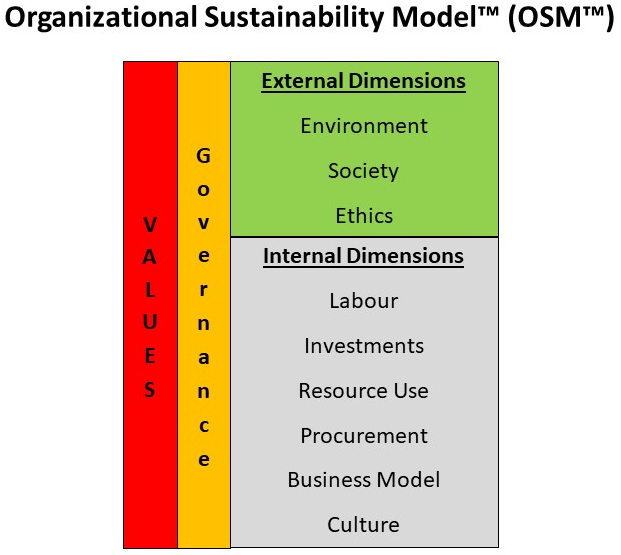ISC's Organizational Sustainability Model
Through extensive involvement of academics, private industry, and sustainability advocates, the ISC has developed its Organizational Sustainability Model™ (OSM). This model combines and adapts the elements of the United Nations' Sustainable Development Goals (SDGs) and the GAPFRAME, a normative framework that translates the SDGs into four sustainability dimensions (planet, society, economy, and governance) that encompass 24 issues and 68 underlying indicators and which can serve as a basis for stakeholders to address sustainability issues.
The OSM further expands on the GAPFRAME, identifying nine dimensions of organizational sustainability, plus the values and governance models that are needed to drive an organization towards a more sustainable future. The OSM contains the following elements, each of which are described in more detail, below.

The OSM is comprised of three external dimensions and six internal dimensions.
External Dimensions
The three external dimensions of organizational sustainability represent the direct impact the organization has on the planet and its inhabitants with whom the organization has no direct relationship; for example, how a manufacturing plant's handling of its waste may impact local communities, or how tax avoidance affects local societies by starving local governments of funding to provide basic services. External dimensions are the first elements most people think of when considering an organization's sustainability. The three external dimensions are:
- Environment — This dimension covers protecting the land, water, and air plus the flora and fauna with whom we share these resources. In addition to basic protections, this dimension looks at how an organizations manages its waste throughout its lifecycle.
- Society — The Society dimension covers poverty and development, the protection and promotion of various local cultures and the rich diversity they bring to our world, and building sustainability awareness.
- Ethics — Ethics addresses a number of issues including corruption, extortion, bribery, money laundering, arms sales (peace), and tax evasion.
Internal Dimensions
The OSM includes six internal dimensions that cover how an organization's behaviour affects stakeholders within its sphere of direct influence, such as investors, employees, and trading partners. The internal dimensions are often missed or incomplete in other organizational sustainability frameworks. The OSM team combined elements from many other sustainability models to come up with the following list of internal dimensions:
- Labour — An organization's workers are at the heart of how an organization operates. This dimension looks at how those workers are treated. It addresses elements such as fair pay, equity, respect for organized labour, worker representation in management decisions, investments training and development, job quality, health, safety, and preparing the future generation.
- Investments — How an organization directs it's funds tells us a lot about its values and true intents. This dimension looks for investments in reducing the enivronmental impact of the organization, improving efficiencies, and adapting the organization's infrastructure to withstand future climate-related hazards.
- Resource Use — We have a finite amount of resources available on our planet. How we use them, re-use them, and ultimately dispose of them reveals a lot about an organizations's impact on the world. This dimension examines resource efficiency and reuse across several elements.
- Procurement — Organizations can influence their suppliers through procurement policies and practices. This dimension looks at how an organization can foster development through its procurement practices and how it can hurt overall sustainability through predatory negotiation tactics.
- Business Model — An organization's business model must be able to run over the long term, else the organization itself will not survive. This dimension examines the structural resilience of the organization, the length of its planning horizons and are its business operations able to continue (or be renewed) over the long term. For example, an organization fully dependent on exploiting a limited resource will be out of business when that resource is no longer available.
- Culture — Finally, how values are expressed, prioritized and enforced reveals a lot about an organization's culture. So does its level of openness and transparency, how it engages its stakeholders, and how it deals with constructive criticism.
Governance Structure
The nine dimensions of organizational sustainability will not manifest (or flourish) in an organization without supporting organizational values and a governance structure that ensures the values are put in to practice in both strategic direction and daily operations.
- Values — An organization's values should inform every policy, procedure, and decision. Its values are the compass that point towards a better future for all. Examining this factor reveals the underpinning moral compass of an organization.
- Governance — Lastly, one must assess the governance controls put in place to ensure that the organization's values are used when steering the organization and making decisions, wether policies are communicated and enforced in the organization, and whether they address risk factors such as those driven by climate change.
Basis for Assessments
Under each of these dimensions, the OSM development team has identified a number of factors with guidelines for determining whether an organization's performance against each factor supports the overall sustainability of the organization. Assessment tools have been developed to help gather, analyze, and report on an organization's overall sustainability level and to provide guidance on how an organization can improve its sustainability level over time.
ISC has trained a number of assessors around the world on how to assess organizations against the OSM, using ISC's tools and processes. If an organization meets a minimum threshold as determined by the assessment, then the ISC may issue a certificate to the organization attesting to its level of sustainability. For more information on the assessment process, please click the button below:



